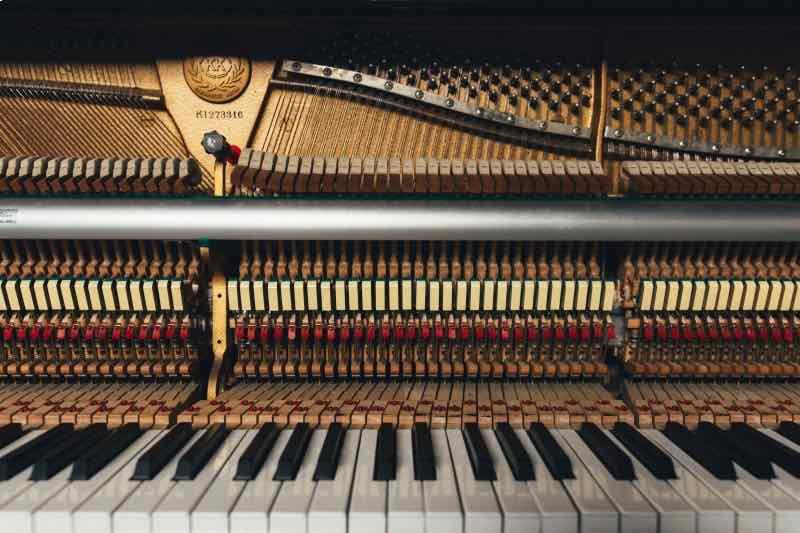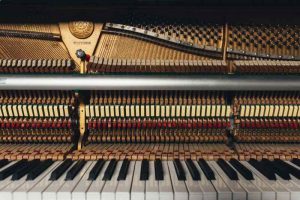Learning how to tune a piano is both a science and an art. Most people think that if you can play the piano, then you can also tune your piano. While this may be true, it is not as easy as you might think. It takes time to understand the mechanics of the piano. And it takes skill to manipulate the various parts to make the piano sound magnificent.
Let’s take a look at the tools needed and the layout of the inside of the piano. And let’s delve into the steps taken to ensure all 220 strings plus will achieve the best results.
We’ll also ask the question, is tuning an acoustic piano better than an electric keyboard?
Luckily, you can buy your tools inexpensively from Amazon or other retailers.
You need:
- A tuner (or app)
- Wedges
- A tuning lever with a removable hex head
Twenty-five years ago or so, most tuners also needed a good ear. But nowadays, it’s not as necessary because of all of the electronic tuners and apps available to guide your ear. Regardless, the human ear usually hears pitches as flat when going up higher on the keyboard, and hears pitches go sharp when going down the keyboard.
This is something to keep in mind: your ear will likely pull towards the middle, where speech is heard.
Taking a Look Inside the Piano
To understand how to effectively tune the piano, it is good to have some knowledge of the layout of the inside of the piano. A piano is different from its predecessors the harpsichord or clavichord, because today, the strings are hit with a felted hammer instead of being plucked.
This was a momentous change in keyboard instruments. The modern piano can play loud and soft, and that’s why it was originally called a pianoforte (Italian for soft/loud).
Piano strings are grouped together by 3’s, and you will need to tune three at a time, starting with the middle string.
Getting Started
Put a wedge in between the strings in order to mute the two that you are not working on. With your tuner set to A (440 HZ) for reference, register your middle octave and tune to a perfect fourth.
The pins are generally hard to turn, but if you turn them clockwise the pitch will go sharper. If you turn them counterclockwise, then the pitch will go flat.
Follow the Circle of 5ths to tune all of the 220+ strings.
Setting the Pin
In order to “set the pin”, move it in such a way that it does not slip back, then strike the key firmly while turning the lever. This way, the vibrations equalize the tension over the string. This will enable the piano to stay in tune longer.
With the harmonics that one hears when striking a key the goal is to temper (or change the width of intervals) to fit within an octave. Equal temperament is when all intervals are slighting out of tune but produce the best sound no matter what key a song is played in.
The ideal is to tune with mathematically calculated frequencies that have precise intervals between the notes.
Pros & Cons of Tuning Your Own Piano
While tuning a piano yourself is doable, there can also be some disadvantages and even possible damage to your instrument. A professional piano technician will know how to stretch the octaves for the best sound, and will be less likely to break a string or to loosen a pin.
They are also trained to make repairs such as regulation (adjusting the hammers) and voice (servicing the wool pads on the hammers). We can never replace experience when it comes to a professional piano technician who tunes a piano that lasts and keeps its tune.
Is It Better to Get an Electric Keyboard?
So, why not an electronic keyboard instead of an acoustic piano? As a piano teacher, I get this question all the time. Just as with pianos, there are various levels of keyboards and some are better than others.
Usually if the keys are weighted, which means the harder you push the louder the sound, and is close to or equals a regular 88 key piano, then that is better. The plus side to a keyboard is that you can more easily carry it with you and use your own instrument for performances instead of always relying on what is already in the performance space AND, it doesn’t have to be tuned! You will save on tunings but if you are playing in a group, they will need to tune to you since you can’t change.
Piano Tuning is a Journey
To tune a piano is labor intensive, and requires tools, good listening skills, and lots of patience. It might be best to start with “touch-ups” before you dive into a full tuning.
Make sure to keep your instrument in the best shape possible so we can all hear beautiful sounds from the best instrument ever … the PIANO!
Dorothy Clark

